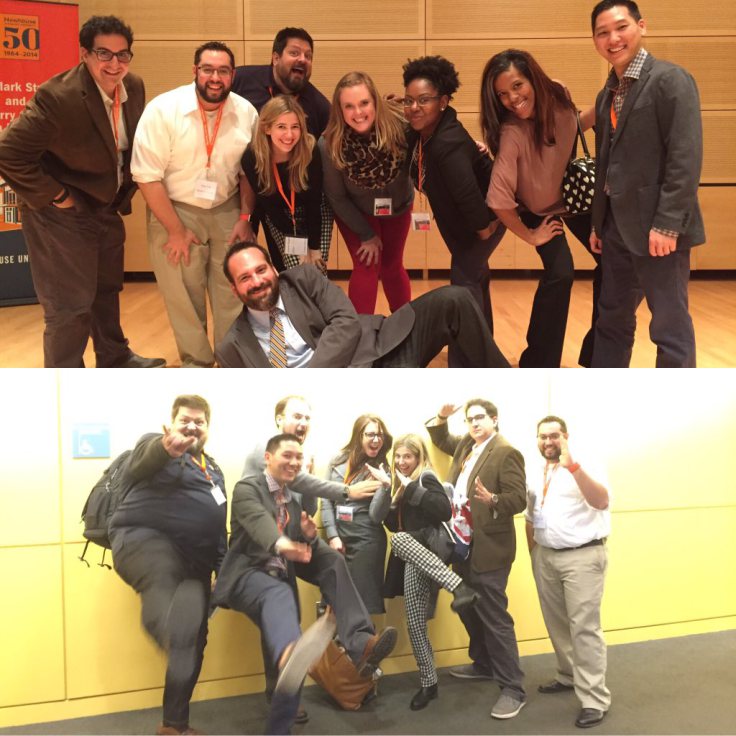Student Perspective: Immersion Experience
The following is a guest post by Communications@Syracuse student David Onoue.
When I made the decision to apply to the Communications@Syracuse program, the thought of earning a master’s degree from one of the top communications schools was incredibly appealing, and being able to complete the program online — since I live more than 5,000 miles away from Syracuse — was a big draw.
As I was deciding whether or not to apply, my admissions counselor spoke to me about immersion weekends where I’d be able to come to the campus, meet faculty, network with other students and learn about a particular topic.
I saw the immersion as a great opportunity to visit the Syracuse University campus and see what a top-notch communications school looks like, but it was not the feature that sold me on the program.
After this past weekend, however, I think the immersion experience is a true game-changer.
I was traveling from Hawaii (yes, that nine-hour flight to JFK was brutal), so I decided to get in a day early; I had been warned the weather in Syracuse is very unpredictable.
I had missed one of my live classes due to travel, so I made arrangements with the professor to visit him during office hours to go over what I missed.
Initially I was a little nervous. I wasn’t sure how I’d be received, as my entire interaction with this professor was through a webcam. I wasn’t sure if I would be treated like an outsider because I was taking classes online.
When I got to his office, another student was speaking with him but as soon as she left, Professor Gitner welcomed me to Syracuse and we had a nice little chat. I was able to get feedback on a project, and the fear that I might be treated like an outsider quickly went away. To him I was a student he was helping to understand the concepts.
That night I met up with two of my classmates, who also arrived early, and we went out for dinner at the famed Funk n’ Waffles, which everyone needs to try. Their Jive Turkey was AMAZING!
The first day of the immersion was pretty interesting.
Meeting my classmates for the first time in person was quite an experience. Each time I saw one of my classmates there was a little pause followed by eye contact, which was pretty funny because we were all unsure if the person we were looking at was indeed a classmate. Then we happily greeted each other.
As the immersion began we were welcomed by Dean Lorraine Branham and Associate Dean Joel Kaplan, and went straight into two presentations.
The first presentation, The Greatest Change in Media History, was from Vin Crosbie, an adjunct professor. His talk focused on the rise of individuated media and new media chromodynamics, which was a lot to take in but very fascinating.
The second presentation, Why Media Leaders Need to Understand Branding, from Lisa Unsworth and Pam Hamlin of Arnold Wolrdwide, took a look at how media companies and brands can come together to create meaningful connections. As I’ve known for a while, it all starts with understanding the brands you are working with.
We then listened to a panel session, 21st Century Challenges for Media Leaders, with Larry Kramer, Tim Kennedy and Nomi Bergman. They spoke about a lot of issues the media industry is facing and to be brief (since I know this is a long post), this is a very interesting time to be in the industry, as there will soon be many changes happening.
The night ended with a networking dinner, which I really enjoyed. It gave all of us a chance to meet with our professors, potential professors and network more with fellow classmates.
Prior to the immersion I had a conversation with Professor Takahashi on Twitter regarding the Journalism Innovation track, and I was fortunate to speak with him at this networking dinner. I asked him about the course he’s teaching, and he also gave me some pointers about conducting interviews using an iPhone.
The second day of the immersion was gold for me.
We started off the day listening to Melanie Deziel, director of creative strategy at Time Inc., who spoke about native advertising, and I may be a little crazy to say this, but this presentation may be a life-changer for me.
Going into the program I wanted to pursue the Advertising track, as this is where I have the most experience. However, after speaking with Professor Takahashi on Friday night and listening to Melanie’s presentation the following morning, it is now clear to me that I need to pursue the Journalism Innovation track.
I was aware of native advertising but from the social platform side, not from a journalism point of view. When Melanie talked about the native ad she did for Netflix, Women Inmates: Why the Male Model Doesn’t Work, a light bulb immediately went off in my head.
When you consider the problem advertising is currently facing with ad blockers, there hasn’t been a real solution, but I feel native advertising (from the journalism point of view) is the future of advertising and the first step toward creating better user experiences.
Looking back at my experience this past weekend, I really wish all of my classmates could have made it out. We created bonds with each other, made networking connections and learned about media leadership and change.
This is definitely an experience I will not forget!



